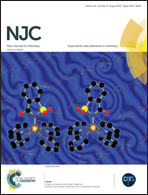Facile synthesis of fluorescent polyaniline microspheres and their use for the detection of mercury ions†
Abstract
Bright blue fluorescent polyaniline (PANI) microspheres with a high quantum yield have been successfully prepared by a simple controlled oxidation of aniline under mild conditions. The fluorescence of the PANI microspheres was quenched by silver nanoparticles (AgNPs) via fluorescence resonance energy transfer. In the presence of Hg2+, the fluorescence was recovered by the release of AgNPs from the PANI microspheres, which were used to construct a simple, highly sensitive fluorometric Hg2+ probe, with a detection limit as low as 0.86 nM. This probe also exhibits excellent selectivity against other metal ions. More importantly, the as-prepared fluorescent probe is also successfully applied for the determination of Hg2+ in real water samples. Thus, the study reported here will open up a new avenue for the construction of novel PANI-based fluorescent probes, and should have great potential applications in Hg2+ monitoring in the environment and in food.


 Please wait while we load your content...
Please wait while we load your content...